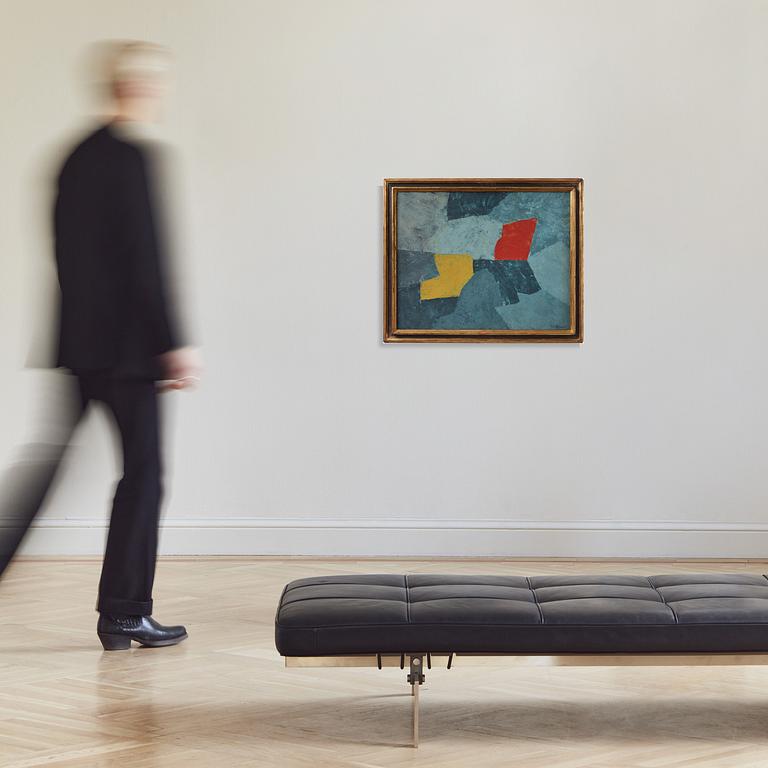Serge Poliakoff
"Composition taches rouge et jaune".
Signed Serge Poliakoff. Executed in 1954. Canvas 73 x 92 cm.
Provenance
Previous in diamond dealer Myran Eknayan' s collection, Paris.
Ader, Picard, Tajan, Hotel Drouot, "Collection de Monsieur Eknayan", Paris, 22 March 1985, cat no 27.
Private collection (acquired at the auction above).
Bukowski Auktioner, Höstens Moderna Auktion 557, 26 October, 2010, cat. no. 330.
Acquired at the above sale, thence by descent to present owner.
Literature
Alexis Poliakoff, Serge Poliakoff, Catalogue raisonné, vol II, 1955-1958, 2010, page 93, no 55-71, reproduced.
The authenticity of this work has kindly been confirmed by Alexis Poliakoff and is registered in his archives with number 955036.
More information
Serge Poliakoff is one of the foremost representatives of the development of abstract painting in the period following World War II. Born in Moscow in 1900, Poliakoff fled Russia in the wake of the Russian Revolution of 1917 and eventually ended up in Paris in 1923. He studied at both the Académie Forchot and the Académie de la Grande Chaumière in 1929, followed by further training at the Slade School of Fine Art in London in 1935. After returning to Paris, he became acquainted with Kandinsky and the Delaunay couple. Poliakoff's painting then became related to the new abstract painting in works with emphasized surface qualities, which could be characterized by geometric-linear formal relationships, but also often concentrated solely on the interplay and contrasts between masses of color. Poliakoff soon came to be regarded as one of the most important representatives of the so-called Ecole de Paris. From 1938 to 1945, he regularly exhibited at the Salon des Indépendants, and thereafter he was one of the most prominent exhibitors at the Salon des Réalités Nouvelles. Poliakoff's position as one of the foremost names in the avant-garde of abstract painting was strengthened in the postwar period. He left his earlier positions in favor of a distinctive development that sought the fundamental in color through constructions of painterly overlapping color surfaces.
In the years immediately after the war, Poliakoff made his palette noticeably darker and painted in muted, diffuse ochre and earth tones in a deliberate attempt to counteract an overly decorative and colorful effect of his abstract structures. These, possibly with scattered, more brightly colored elements, characterized his painting until the mid-1960s. In the early 1950s, when Malevich's work gave him a strong impulse, his painting developed into a firm and almost canonical repertoire of forms whose relatively one-sided character further emphasized the color surface and the sensual effect of color pigments. Poliakoff was driven by a desire to focus on the material more than on the representational form. The previously sharp and pointed forms and contrast play were replaced by his characteristic blocks or large forms that, like softly toned textures with brittle boundaries, cling to each other in harmonious and restrained compositions.
The auctions work "Composition taches rouge et jaune" was executed in 1954 and is a very good example of Poliakoff's painting during this important period for the artist. The provenance of the painting is also of interesting nature as it was previously part of the well-known Myran Eknayan's collection. Myran Eknayan (1892-1985) was a diamond dealer and had a jewelry firm on the prestigious Place Vendôme in Paris. Eknayan was a great and well-known collector of classical antiquities, preferably from the Château de Versailles, as well as works by old masters and art up to and including the Impressionists: Monet, Manet, Renoir, Degas, and Bonnard. In addition, there were also sculptures by Rodin and Claudel. When Eknayan met Jacqueline Delubac, a renowned actress and former wife of theater man Sacha Guitry, the home was also filled with contemporary art: Léger, Braque, Picasso, Modigliani, Poliakoff, Dufy, and Bacon. Jacqueline herself came from a wealthy family with silk weaving in Lyon. The couple lived together for about ten years and their famous art collection was very much alive. The couple bought and sold objects and parts of the collection were exchanged over time. In 1985, the couple decided to sell a significant collection of works by Serge Poliakoff. 14 works were sold through the auction firm Ader, Picard, Tajan at the Hôtel Drouot in Paris on March 22, 1985.
After her husband's death, just a few months after the auction mentioned, Jacqueline Delubac-Eknayan paid the inheritance tax - they were both childless - with "Le déjeuner sur l'herbe" by Manet through a so-called "dation"! "Dation" is a way to pay high inheritance taxes, initiated by André Malraux as Minister of Culture in 1968, so that significant works of art in private collections would go to French museums. The work is now one of the absolute highlights of the collections at the Musée d'Orsay. In 1992, five years before she died after being hit by a cyclist, Eknayan's widow decided to bequeath 34 works by the most significant French masters to the Musée des Beaux-Arts, Saint-Pierre, in her hometown of Lyon. "Composition taches rouge et jaune" is one of the significant works that was sold at the aforementioned auction in Paris in 1985. The work is not only an excellent example of Poliakoff's painting at its best but also a culturally significant object in that it previously belonged to the "Collection Eknayan".


























































